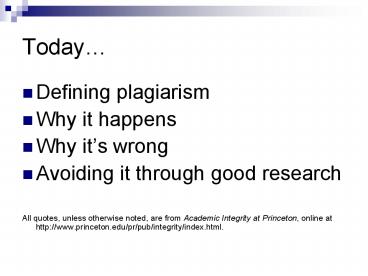Today - PowerPoint PPT Presentation
1 / 19
Title:
Today
Description:
All quotes, unless otherwise noted, are from Academic Integrity at Princeton, ... From Webster's Third New International Dictionary of the English Language, ... – PowerPoint PPT presentation
Number of Views:71
Avg rating:3.0/5.0
Title: Today
1
Today
- Defining plagiarism
- Why it happens
- Why its wrong
- Avoiding it through good research
- All quotes, unless otherwise noted, are from
Academic Integrity at Princeton, online at
http//www.princeton.edu/pr/pub/integrity/index.ht
ml.
2
The Academic Challenge
Go beyond
- what you learn in
textbooks, in lectures, and in the library - Evaluate, rethink, synthesize, and
- the information, data concepts you find.
- is where satisfaction comes from
make your own
Making something original
3
Your Voice
Your voice
4
What is plagiarism?
- to steal and pass off as ones own (the ideas or
words of another) - to use a source without crediting it
- to present as new and original an idea or product
derived from an existing source. - From Websters Third New International Dictionary
of the English Language, Unabridged, p. 1728, as
quoted in Lathrop and Foss, p. 116.
5
Plagiarism Simplified
- If you didnt think of it
- and write it all on your own,
- and you didnt cite the sources where you found
the ideas or words, - its probably plagiarism.
- Lathrop, A. and Foss, K. (2000). Student Cheating
and Plagiarism in the Internet Era. Englewood,
CO Libraries Unlimited, Inc., 116.
6
How does plagiarism happen?
- Deliberate usually involves the whole paper
- purchased from a research service
- found on the Web
- re-using another students term paper
- written for the student by another person
- Unintentional or accidental usually partial
- using anothers words without quoting or citing
- paraphrasing anothers words without citing
- failure to cite source of information which is
NOT common knowledge
- WARNING
- Whether you plagiarize intentionally or by
accident, it is still plagiarism.
7
When do I need to cite?
- 1. When quoting directly from the text.
- (Use quotation marks, and cite your source.)
- Do not use quotation marks, but still cite if
you - 2. Paraphrase (restate)
- 3. Summarize
- 4. Provide facts
- that are not common knowledge.
8
What is common knowledge?
- A fact or piece of information that is generally
known and accepted. - Example
- There are 50 states in the United States.
- George Washington was our nations first
president. - The weather is generally cold at the North and
South Poles.
9
What is not common knowledge?
- Examples
- The Chinese fishing industry produces 800,000
tons of fish annually (Toussaint-Samat 328). - The first international coffee syndicate was
based in Germany (Toussaint-Samat 590). - No quotation marks needed because they
- aren't the original authors' words
- But must be cited because they include facts
- that are not commonly known.
- Common knowledge varies depending
- on your audience.
10
Are citations enough?
- Citation must be accompanied by a
- bibliography of sources
- You must cite ALL types of sources
- Do not list sources that you have not read.
(fabrication)
When in doubt, cite your source.
11
Why does plagiarism happen?
- Lack of understanding about
- the research process and how to properly cite
sources - why you need to cite your sources
- how plagiarism hurts others
- Procrastination-
- citing takes time and good note-taking habits.
- Increase of information online
- Pressures to succeed
12
Reasons to Cite Your Sources
- Establish the credibility of your work
- Acknowledge use of others ideas and clearly
distinguish them from your own - Receive credit for what you have done
- Place your ideas within the greater academic
dialogue - Allow the reader to find your sources
13
Myth and Fact
- MYTH
- Im not hurting anyone if I plagiarize.
- FACT
- If you plagiarize, you are hurting yourself AND
other people. It impedes your learning and
thinking process.
14
Plagiarism hurts other students
- University of Illinois 2000 study found
- The grading curve was affected by dishonest
students. - After plagiarized papers were marked down and the
curve adjusted, the grades of honest students
went up. - Example B ? B for honest students
15
Plagiarism hurts you.
- There are severe penalties at Drexel for
plagiarism. - Plagiarists are not learning to do the good
research required now AND in the future.
http//www.drexel.edu/StudentLife/
16
Automated Plagiarism Detection Service
17
Strategies to Help You Avoid Plagiarism
- Start assignments early
- Use the Library
- Rich source of easily cited information
- Citation guides are available
- Use Refworks
- Librarians can help you
18
Tutorials
- Hagerty Librarys online tutorials
- Evaluating Information on the web
- Plagiarism Tutorial
- Citation Style Sources
- How to cite electronic resources
- Refworks Handout
19
Thank you!!
- Jay BhattInformation Services LibrarianEngineeri
ngTEL 215-895-1873FAX 215-895-2070EMAIL bhattjj
_at_drexel.edu - Our IS staff
- Credits Emily Devaney Missner Tim Siftar































